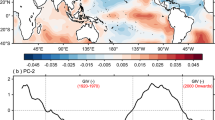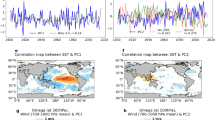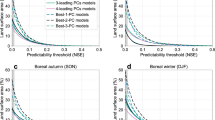Abstract
Several recent studies1–6 have described associations between inter-annual variations of the Indian south-west monsoon and the El Niño–Southern Oscillation (ENSO) phenomena, and methods for predicting monsoon rainfall based on these associations have been proposed. Rasmusson and Carpenter5 suggested that sea-surface temperature (SST) anomalies appearing along the equatorial Pacific South American coast early in the year can provide useful predictions of Indian monsoon rainfall, while Shukla6 suggested that the change in atmospheric pressure anomalies at Darwin from winter to spring (Northern Hemisphere seasons) was useful. It has also been demonstrated8–11 that SST anomalies in the Indonesia–north Australia region are closely related to the ENSO phenomena. I examine here the relationship between Indian south-west monsoon rainfall and Indonesian–north Australian SST and provide evidence suggesting that SST anomalies in this region can be used to predict Indian monsoon rainfall as accurately as the techniques proposed previously, but using data available several months earlier.
This is a preview of subscription content, access via your institution
Access options
Subscribe to this journal
Receive 51 print issues and online access
$199.00 per year
only $3.90 per issue
Buy this article
- Purchase on Springer Link
- Instant access to full article PDF
Prices may be subject to local taxes which are calculated during checkout
Similar content being viewed by others
References
Khandekar, M. L. Arch. Met. Geophys. Bioklim. A28, 159–168 (1979).
Weare, B. C. J. atmos. Sci. 36, 2279–2291 (1979).
Pant, G. B. & Parthasarathy, B. Arch. Met. Geophys. Bioklim. B29, 245–252 (1981).
Angell, J. K. Mon. Weath. Rev. 109, 230–243 (1981).
Rasmusson, E. G. & Carpenter, T. H. Mon. Weath. Rev. 111, 517–528 (1983).
Shukla, J. Mon. Weath. Rev. (in the press).
Philander, S. G. H. Nature 302, 295–301 (1983).
Newell, R. E., Selkirk, R. & Ebisuzaki, W. J. Climatol. 2, 357–373 (1982).
Rasmusson, E. M. & Carpenter, T. H. Mon. Weath. Rev. 110, 354–384 (1982).
Nicholls, N. Ql Jl. R. met. Soc. 105, 93–105 (1979).
Nicholls, N. Mon. Weath. Rev. (submitted).
Author information
Authors and Affiliations
Rights and permissions
About this article
Cite this article
Nicholls, N. Predicting Indian monsoon rainfall from sea-surface temperature in the Indonesia–north Australia area. Nature 306, 576–577 (1983). https://doi.org/10.1038/306576a0
Received:
Accepted:
Issue Date:
DOI: https://doi.org/10.1038/306576a0
This article is cited by
-
Delineation of most favorable winds for southwest monsoon rainfall along Kerala coast
Theoretical and Applied Climatology (2023)
-
Value addition to forecasting: towards Kharif rice crop predictability through local climate variations associated with Indo-Pacific climate drivers
Theoretical and Applied Climatology (2021)
-
Relevance of Indian Summer Monsoon and its Tropical Indo-Pacific Climate Drivers for the Kharif Crop Production
Pure and Applied Geophysics (2018)
-
Simple Multiple Regression Model for long range forecasting of Indian Summer Monsoon Rainfall
Meteorology and Atmospheric Physics (2008)
-
Seasonal phase-locking of peak events in the eastern Indian Ocean
Advances in Atmospheric Sciences (2007)
Comments
By submitting a comment you agree to abide by our Terms and Community Guidelines. If you find something abusive or that does not comply with our terms or guidelines please flag it as inappropriate.



